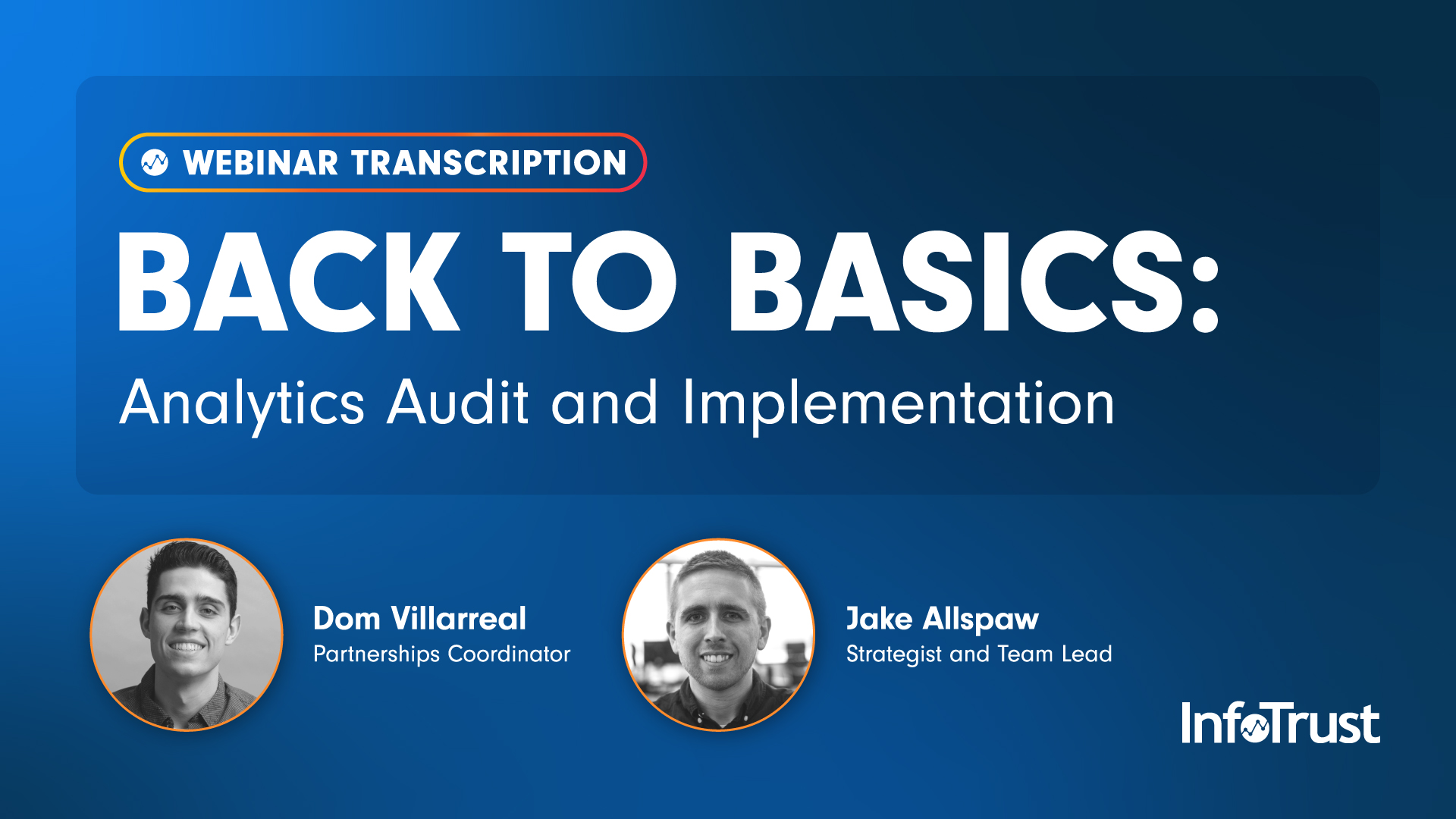Wondering what an audit and implementation is or why you should consider conducting one for your organization? Today, we’re going back to the basics and sharing what we’ve learned over the years at InfoTrust, as well as how you can get started with your own audit and implementation today.
What is an audit and implementation?
An audit and implementation is a reassessment and configuration of your digital architecture, reevaluating what you have in place right now. What are you currently using and collecting about your users as they come onto your websites and your mobile application? Next, how can you optimize and make important metrics easier to understand your users and drive success at your organization?
There are two types:
- First-party audit and implementation – This specifically looks at your analytics platform and tag management system; then evaluating how you’re currently collecting first-party data, and how customers are interacting with your site.
- Third-party audit and implementation – This reviews all media platforms loading on your website. It’s important to understand what is loading on your site from a data governance standpoint and if you are adhering to regulations.
Both types of audit and implementations’ purposes are to instill a complete data collection process ensuring all teams needs are met—making sure that all stakeholders are able to identify the information they need to drive their KPIs and be successful. For this article, we’re specifically focused on first-party audit implementations.
Why should you consider an audit and implementation?
We’ve narrowed it down to four business use cases:
- There’s no alignment with your organization’s objectives. – You’re merely collecting data for the heck of it. The issue with this approach is that you’re not making the most of your investment and not seeing the value in the data. So the purpose of an audit and implementation here would be to make sure that your analytics platform and your tag management system align with what you’re trying to accomplish as an organization.
- There’s little to no trust in your analytics data or there’s a lack of consistency. – It’s not that the teams don’t see the value in your analytics platform, but rather they just don’t trust it. Sometimes things break—and as more things begin to break, it becomes more of a struggle for your analytics or marketing teams to fully understand the user journey. Without that information, it’s difficult to make any data-driven decisions. An audit and implementation from this perspective would help identify those quick wins and gaps right away so that you’re able to make the necessary changes for a consistent flow of data again.
- You’re considering dual-tagging. – One of the biggest reasons to move forward with dual-tagging is because of Google’s latest iteration and the future of analytics, Google Analytics 4 (GA4). With the recent sunset announcement of its current version, Universal Analytics, dual-tagging becomes even more important now to ensure you’re able to collect the same or similar metrics as the former UA. As GA4 is an event-based model, GA4 will ensure you have a unified view of how you’re collecting information about your users from both websites and your mobile applications. Dual-tagging is also important because GA4 is not up to parity with Universal Analytics just yet (though it’s close!). We recommend understanding how you currently have Universal Analytics deployed on your website and then trying to find a way to translate that over to GA4 so that when you upgrade, you’re collecting the metrics that are really important to you and you’ll have that historical data already in place once Universal Analytics deprecates. Having both on your website will act as a great spot-check to make sure there is consistent flow between the two platforms.
- Remember you are migrating to a different analytic stack. – As you review one analytic stack you’re getting rid of and you identify what you’re collecting/need to continue to collect, think about how that’s going to translate to the next platform you are moving to and what nuances you need to be aware of.
Technical Perspectives for Consideration
Stakeholder interviews – These are a crucial part of the process because they serve as an opportunity to understand your organization’s priorities, what truly drives business, and what KPIs are used to measure the success of your digital efforts. These interviews also help uncover pain points, discrepancies, and challenges that the people in your organization are facing when it comes to data and reporting. This step allows stakeholders to voice those concerns.
Evaluate your data collection methods – When you’re looking at your data collection methods, it’s important to ask how does this match or not match what is established in the stakeholder interviews? There are a few layers to audit here:
- First, is the website tagged properly? Is your data layer implemented consistently? Are your tags picking up that data properly?
- Next, we’ll look at the tag management system. Is it processing data correctly and sending it to your analytics properties as intended?
- And finally, we’ll take a look at the analytics platform user interface. Is data presenting in reports as you’d expect?
Review the analytics architecture – Do you have consistency across various markets, brands, and websites? Is everyone speaking the same language when it comes to data? This is what allows your organization to get the real payoff of analytics—applying learnings from one area of the business to another and that’s only possible with consistency. While this is a laborious and time-intensive process, it’s well worth the time.
Communicate with stakeholders – Now’s the time to chat with stakeholders and let them know what you’ve discovered and what changes need to be made, as well as why those changes need to be made. This will also give your teams an opportunity to provide feedback on your findings and recommendations to ensure you’re not just following a cookie-cutter approach of best practices.
Create an implementation guide – After your recommendations are presented, discussed, and approved, it’s time to build out standards for your organization, likely in the form of an implementation guide, or measurement plan. And again, this is a very time consuming process—but it’s imperative if you want to avoid the same problems you just identified. Rome wasn’t built in a day, so make sure the pace is communicated with your team and expectations are clear about what the outcome will be and when. The guide will be a technical document; it should include specific details about where tracking should be implemented, what values and variables should be collected in the code snippets themselves, or at least examples of code. Also, it’s very important that you have a trusted development team, as the actual labor of implementation will fall on them. As changes are made to your properties it’s crucial they’re tested, so you can make sure that the data is collected as intended. Beyond the initial validation of the implementation, ongoing support is likely needed as updates will be rolled out gradually and new requirements are identified and therefore need to be implemented.
What Next?
Now that you know what an audit and implementation is, where do you go from here? Here are a few considerations:
Assess Your Six Ps
The Ps of visual analytics transformation is a way to reevaluate what you have in place overall, where you want to be, and again, helping use those two types of information to develop a roadmap for you to get from point A to point B.
- Purpose – What’s the overall goal of the organization, but then looking at it from an online experience perspective; what’s the overall goal of this website and our mobile applications?
- People, platforms, and processes – Who do we have on our team right now and what are their skills? Where do they lack experience that we may need help with? How are we analyzing our users’ online behavior? What analytics platforms, tag management systems, or other marketing platforms are we using? What do we do with the data we collect? Do we just put it away for storage? How are we reporting on it? And how are we sharing that? Are we sharing with leadership?
- Pace and payoff – Once you have this information, how quickly can we make a business decision to act on it? And, looking at the list of priorities, what’s the biggest payoff for us as an organization right now, in the short term and long term? Which way do we need to prioritize the different tasks that we have to do?
Once you assess your six Ps, you should then have an idea of what you need to collect and that’s when you can start developing that roadmap to achieve digital transformation. At this point, you need to determine if you can do it in-house, or you can partner with a trusted consultancy like InfoTrust.




